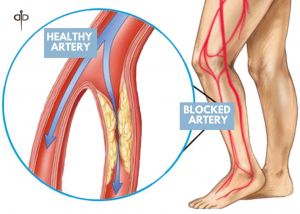Is there a link between smoking and Peripheral Arterial Disease (PAD)?

What is PAD?
Peripheral arterial disease (PAD) develops when excessive plaque accumulates in the arteries. As a result, blood flow is restricted, especially in the lower extremities such as the legs, feet, and ankles. Patients afflicted with PAD will typically receive arterial treatments or peripheral arterial treatment to help restore their weakened arteries and are encouraged by their physicians to practice healthy habits at home to combat the painful and potentially life-threatening symptoms associated with PAD. Smoking cigarettes, which are also linked to an array of other serious health conditions, can greatly intensify the severity of PAD. Quitting will not only aid in PAD management but also improve the patient’s quality of life. However, a 2018 study suggests that many physicians are not providing vital resources and potentially life-saving advice to patients with PAD who smoke.
Smoking with PAD
This study examined over 1,200 patients worldwide who suffered from PAD and one-third were current smokers. Even though smoking is known to drastically worsen a person’s symptoms, less than a fifth of these patients was encouraged to stop smoking. Only 10% of those patients who were current smokers were prescribed medication to help them stop smoking.
“Smoking is the single most important modifiable risk factor for peripheral artery disease,” said the study’s lead author, Dr. Krishna Patel – a cardiology fellow at the University of Missouri-Kansas City and Saint Luke’s Mid America Heart Institute- during an interview with The American Heart Association.
“It is associated with faster progression of the disease, greater risk of complications such as limb amputations, heart attacks and death, and also a poor response to treatment.”
The results of this study are not only shocking but also a call to action for Vascular Specialists everywhere.
In the same interview, Dr. Aruna Pradhan- a third-party objective, cardiologist, and epidemiologist at Brigham and Women’s Hospital, a teaching hospital of Harvard medical school- says that physicians are “not doing enough about this issue.”
“We’re guilty of not going out of our comfort zone into areas like nutrition and smoking cessation and lifestyle behavioral modifications. Smoking cessation is an intervention that can prevent the progression of this disease. We really need to get on board,” Pradhan said.
Habitual Changes
Other behavioral changes that can be implemented into daily routines that will help manage PAD symptoms are exercise and a balanced diet. For example, walking 30-60 minutes a day is a low-impact activity that elevates heart rate and stimulates blood flow. Another way you can manage your PAD symptoms at home is through a balanced diet. Reducing your saturated fat and sodium intake will help to reduce the amount of plaque buildup in your blood vessels. Healthy incorporation of foods such as fruits, vegetables, nuts, whole grains, fish, and lean meats will not only increase levels of good cholesterol (HDL-C) but improve your overall quality of life.
While these habitual changes may help manage the uncomfortable symptoms associated with PAD, additional treatment may still be required to strengthen your weakened blood vessels. Our Vascular Specialists at Pedes Orange County treat venous disease conditions and arterial disease conditions on a regular basis. An angiogram is a minimally invasive procedure in which a physician removes the blockage in your arteries through multiple different methods of treatment: atherectomy, angioplasty, and stents.
Minimally-Invasive Treatment Methods
During an atherectomy, a specialist uses a catheter to gently remove plaque stuck in your arteries. While under local anesthesia, the specialist makes a small incision so the catheter can be easily inserted. The catheter gently removes and sucks the plaque out from the small chamber at its tip.
Another method used during an angiogram is angioplasty. A catheter is inserted into the artery to restore blood flow. Once in the artery, a small balloon is inflated at the tip of the catheter. The balloon pushes the plaque against the artery wall. The pressure created by the balloon widens the narrowed arteries, allowing for optimal blood flow throughout the leg.
Finally, a stent is a wiry, mesh tube that is placed within the artery, acting as an internal support system for the damaged walls. This will prevent the arteries from closing after the plaque is removed. Stents can also be coated with medicines to help prevent future plaque buildup.
Each of these procedures is done in Pedes Orange County’s outpatient surgical center, requiring no general anesthesia or hospital stay. Without proper treatment, PAD can lead to a heart attack, stroke, gangrene, limb amputation, and even death. Heart-related health conditions, such as heart attack and stroke, are among the top causes of death in the United States, according to the American Heart Association. Gangrene, tissue death from poor blood flow, has a mortality rate as high as 20% to 40% in affected individuals. Of the 2 million individuals currently living with limb loss in the United States, 54% are a result of PAD.
With treatment and proper integration of healthier habits such as diet and exercise, PAD symptoms can be managed. Patients can live longer, healthier lives. If you think you would benefit from one of our minimally invasive methods or would like to learn more about venous and arterial disease, contact our office today to make an appointment (949) 390-6863












